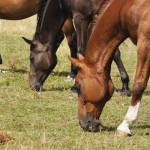Eating Machines: How Much Grass Can Horses and Ponies Ingest?

Traditional guidelines for feeding suggest that an average horse should be given at least 1.5 to 2% of its body weight in combined forage and concentrates per day. Many horses are able to maintain an acceptable body condition on a diet of this size, becoming neither too ribby nor too fat. It has also been suggested that horses will self-regulate, eating just the right amount of grass if given free access to pasture. Again, this does work for many horses.
However, especially for horses on any sort of dietary restriction, the urge to eat can become very strong, leading to virtually nonstop eating if the opportunity arises. Horses can ingest more than 5% of their body weight in 24 hours when grazing good-quality pasture, and ponies have been known to gobble up to 1% of their body weight in only three hours.
Excessive grain consumption is frequently blamed for equine obesity, but horses can become overweight even if they are never fed grain. Instead, grass overconsumption may be one of the most important risk factors for obesity in horses on pasture. The use of drylots and grazing muzzles may be necessary to reduce body weight in these horses, many of which can never safely have free pasture access.
The pH of the hindgut varies as bacterial populations increase and decrease in response to dietary modifications. EquiShure is a time-released buffer targeting the hindgut. A time-released buffer helps moderate gut conditions by preventing the drastic drop in pH associated with high lactate production and supports lactic-acid-utilizing bacteria.








